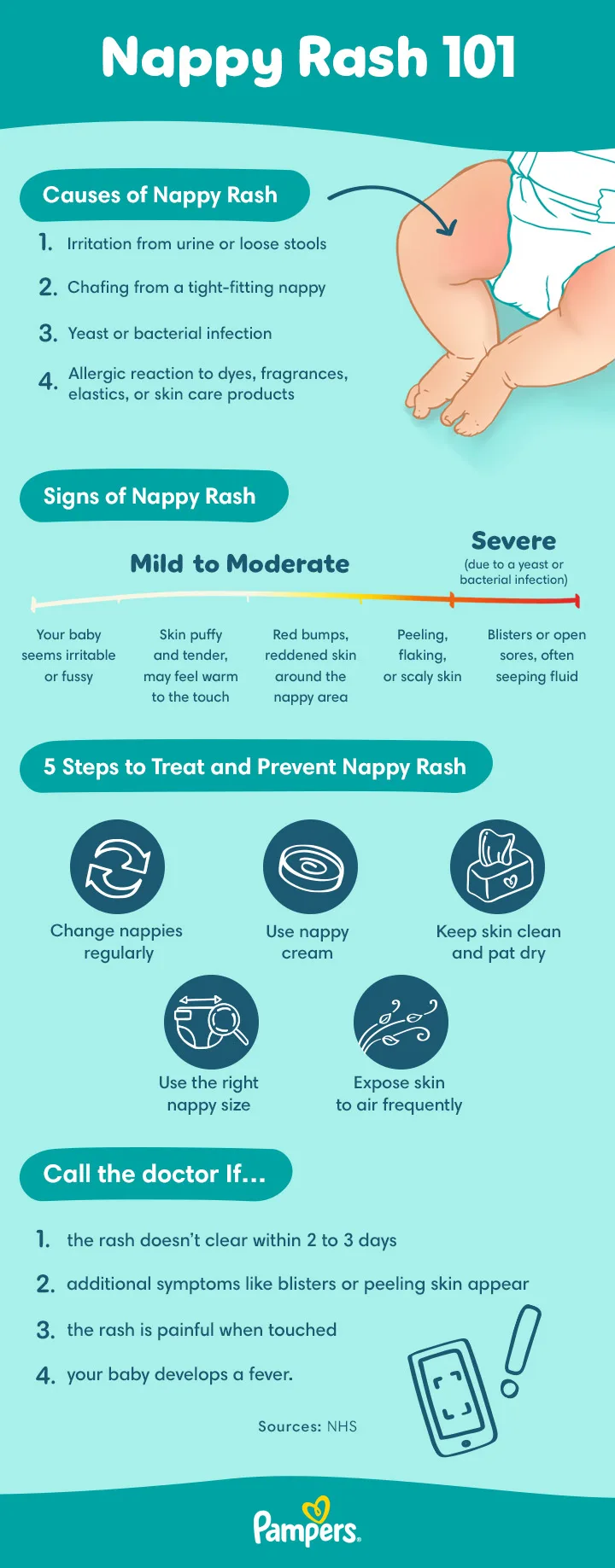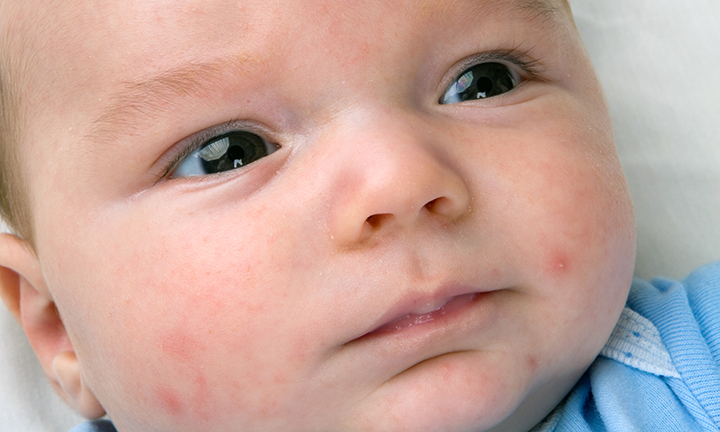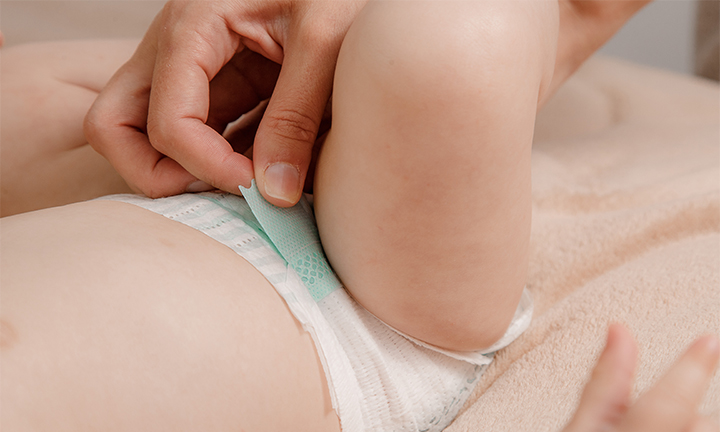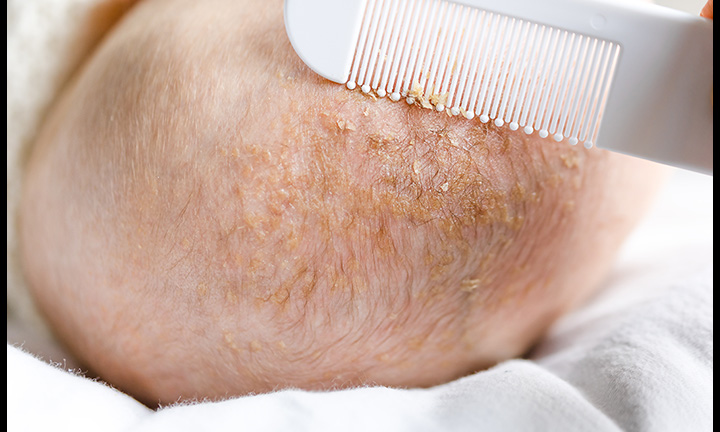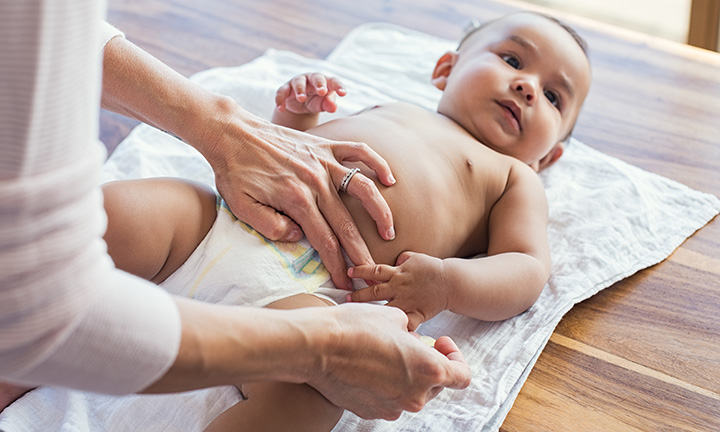
Nappy Rash: Causes, Symptoms and Treatment
Most babies will get nappy rash at least once, even with super-absorbent nappy technology and frequent nappy changes. In most cases, mild nappy rash clears up in a few days with simple at-home treatment. Find out more about what causes nappy rash, what nappy rash looks like, and how to prevent and treat it.
What Is Nappy Rash?
Nappy rash is a common condition that typically forms when the sensitive skin on and around your newborn or older baby’s nappy area becomes irritated, for example if it remains in contact with urine or poo for too long.
Nappy rash can make your baby’s skin red, hot or sore in patches, and sometimes it can cause spots or blisters. With proper treatment, nappy rash usually clears up within three or four days, but if the rash doesn’t noticeably improve within a couple of days, or if it gets worse, see your midwife or doctor for advice.
An important way of protecting your little one against nappy rash is changing your baby’s nappy frequently.
What Does Nappy Rash Look Like?
Common signs of nappy rash can include:
What Causes Nappy Rash?
Even with frequent nappy changes, nappy rash can still happen. In the next sections, we’ll explore some causes of nappy rash and situations in which it might occur.
Nappy Rash Caused by Irritants
Skin irritation is the most common cause of nappy rash, and often it is a result of:
You may notice red patches on your baby’s bottom, or the whole area may be red. Most of the time, babies don’t feel sore if they experience mild nappy rash. However, if the rash is severe your little one may feel uncomfortable and be distressed.
Make sure to change your baby’s nappy regularly, keep the nappy area clean and apply nappy cream. It’s also a good idea to use highly absorbent nappies and make sure they fit correctly without being too tight to avoid chafing.
Fungal Nappy Rash in Babies
If the nappy rash doesn’t clear up within two or three days, your little one may have a fungal infection. In this case, your health visitor or doctor can advise you on the best treatment.
If your baby’s nappy rash is caused by a fungal infection you might see more severe nappy rash symptoms, such as:
Your doctor may prescribe an antifungal cream or medicine. This will usually clear up the infection within a week or so, but you may be advised to keep using it for longer to prevent reinfection.
Bacterial Nappy Rash in Babies
While rare, nappy rash may be caused by a bacteria called impetigo, a skin infection that’s very contagious but not usually serious. Impetigo typically starts with red sores or blisters, which may be harder to see in brown or black skin. The sores or blisters burst quickly leaving behind crusty, golden-brown patches.
If you believe your baby’s nappy rash may be due to a bacterial infection, contact your baby’s GP for diagnosis and treatment. Avoid using an over-the-counter antibiotic cream to treat the nappy rash unless advised to do so by your child’s GP.
Nappy Rash Caused by Allergens
You may find that your baby is sensitive or allergic to certain substances or ingredients, such as:
A rash may show up shortly after your little one is exposed to an allergen. If you notice a rash, consider switching to another type of nappy, wipe or cream for two weeks to see if that helps it clear up. If you suspect a food allergy, try removing that food from your baby’s diet. Visit your child’s GP for a detailed diagnosis, any necessary tests and treatment recommendations.
WHAT'S MY BABY'S NAPPY SIZE?
Nappy Size Calculator
Find out your baby's nappy size, how many nappies you'll need per day and for how long:
Other Skin Conditions You Might Mistake for Nappy Rash
A rash can sometimes be a symptom of something other than just irritated skin. It’s a good idea to familiarise yourself with the symptoms of other common skin conditions so you’ll be able to tell them apart from a simple nappy rash.
Some common baby skin conditions include:
If you’re not sure precisely what might be causing nappy rash or any other rash on your newborn or older baby’s skin, ask your health visitor or doctor for advice. Get more tips on how to care for your little one’s delicate skin.
Nappy Rash Treatment and Prevention
The steps for treating nappy rash and preventing it are very similar, so if you want to know how to get rid of nappy rash as well as help prevent it, try these remedies:
Severe Nappy Rash and Treatment
In some cases, nappy rash may become bad, leading to additional discomfort for your little one. Severe nappy rash might present itself with symptoms like blisters, swelling, and broken or raw skin areas. As we mentioned in the above sections, severe nappy rash might be caused by a fungal infection.
How to treat severe nappy rash, is a common question from parents. If your baby is distressed and the rash doesn’t improve after a few days of implementing the usual nappy rash treatments, it’s best to seek advice from your baby’s doctor or health visitor. Remember, even bad and severe nappy rash can be managed and your baby can feel comfortable again with the right care, remedies and treatment.
When to See the Doctor
Check in with your health visitor or doctor if you think your newborn or older baby’s nappy rash may be caused by a fungal or bacterial infection – this could be the case if the rash lasts longer than a couple of days, especially if it seems severe.
Also let your doctor or health visitor know if your baby has a rash along with a fever or if your little one seems very uncomfortable or distressed.
Seek urgent medical attention if your little one has a rash anywhere on their body that doesn’t fade when you press a glass against it. This could be a sign of meningitis, which needs to be treated immediately.
Other symptoms of meningitis include if your baby seems confused, is breathing rapidly, shaking uncontrollably, seems over-sensitive to light and/or has unusually cold hands and feet.
FAQS AT A GLANCE
Nappy rash can be caused by fungal or bacterial infections. The most common cause is irritation from urine and faeces. However, yeast, thriving in warm, moist environments, can also lead to nappy rash. This is characterised by a bright red rash with small, red bumps on the outer edges. Additionally, a bacterial infection can cause sores and blisters. If nappy rash persists despite usual care or is accompanied by blisters or sores, seek medical advice.
The Bottom Line
Even when you’re careful to frequently change your little one’s nappies, there’s still a good chance that they will get a nappy rash at some point. You can do your best to prevent them by following the above tips, some of which aren’t just great for warding off nappy rash, but for your baby’s overall skin care.
The good news is that most mild cases clear up within a few days with simple treatment and your little one’s skin will soon return to being as smooth and soft as, well... a baby’s bottom!
If the rash doesn’t clear up with these measures, your baby’s GP will be able to recommend suitable treatment. For example, if your little one’s nappy rash is caused by fungus or bacteria, a special cream or medication may be required.
The information in this article is based on the expert advice found in trusted medical and government sources, such as the National Health Service (NHS).The content on this page should not replace professional medical advice. Always consult medical professionals for full diagnosis and treatment.
Read more about Newborn Baby
Related Articles
Join Pampers Club and get:



